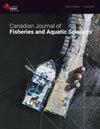Increasing microplastic exposure had minimal effects on fatty acid composition in zooplankton and yellow perch in a large, in-lake mesocosm experiment
IF 1.9
2区 农林科学
Q2 FISHERIES
Canadian Journal of Fisheries and Aquatic Sciences
Pub Date : 2024-08-08
DOI:10.1139/cjfas-2024-0149
引用次数: 0
Abstract
Using 10-m diameter mesocosms in a Canadian boreal lake, we investigated the effects of MP exposure on the body weight and diet of yellow perch (Perca flavescens) and the fatty acid composition of yellow perch and zooplankton. We exposed the aquatic ecosystem within seven mesocosms for 10 weeks to a mixture of polyethylene, polystyrene, and polyethylene terephthalate fragments, ranging in nominal addition concentrations from 6 to 29,240 particles L-1 (although realized water column concentrations were lower), as well as two negative controls. Increasing MP exposure did not affect yellow perch body weight (growth) or diet, or the overall fatty acid composition of yellow perch muscle or zooplankton. Results were highly variable across mesocosms. Despite high levels of MP ingestion by yellow perch, we did not find evidence of MPs leading to food dilution or any other effect where we could anticipate impacts on food web structure.在一项大型湖内中观实验中,增加微塑料暴露对浮游动物和黄鲈的脂肪酸组成影响甚微
我们利用加拿大北部湖泊中直径为 10 米的中型模拟池,研究了接触 MP 对黄鲈(Perca flavescens)体重和食量以及黄鲈和浮游动物脂肪酸组成的影响。我们将七个中置池内的水生生态系统暴露于聚乙烯、聚苯乙烯和聚对苯二甲酸乙二酯碎片的混合物中长达 10 周,这些混合物的标称添加浓度从 6 到 29,240 微粒 L-1 不等(尽管实际水体浓度较低),同时还暴露于两个阴性对照组中。增加 MP 暴露不会影响黄鲈的体重(生长)或饮食,也不会影响黄鲈肌肉或浮游动物的总体脂肪酸组成。不同中置培养箱的结果差异很大。尽管黄鲈摄入了大量 MP,但我们并未发现 MP 导致食物稀释的证据,也未发现任何其他可能影响食物网结构的效应。
本文章由计算机程序翻译,如有差异,请以英文原文为准。
求助全文
约1分钟内获得全文
求助全文
来源期刊

Canadian Journal of Fisheries and Aquatic Sciences
农林科学-海洋与淡水生物学
CiteScore
4.60
自引率
12.50%
发文量
148
审稿时长
6-16 weeks
期刊介绍:
The Canadian Journal of Fisheries and Aquatic Sciences is the primary publishing vehicle for the multidisciplinary field of aquatic sciences. It publishes perspectives (syntheses, critiques, and re-evaluations), discussions (comments and replies), articles, and rapid communications, relating to current research on -omics, cells, organisms, populations, ecosystems, or processes that affect aquatic systems. The journal seeks to amplify, modify, question, or redirect accumulated knowledge in the field of fisheries and aquatic science.
 求助内容:
求助内容: 应助结果提醒方式:
应助结果提醒方式:


